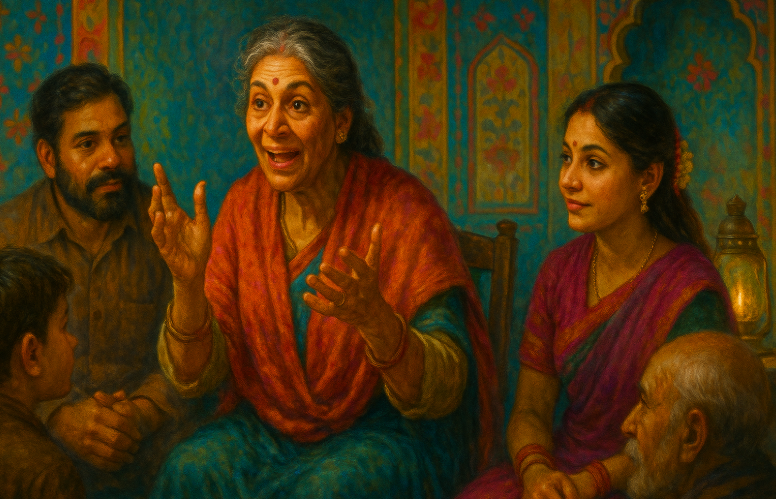In the rural heartland of Malda lies a lesser-known but vital tradition: the legacy of women storytellers and traditional healers. These women, often from ordinary village households, have served as the oral historians, herbalists, midwives, and spiritual guides of their communities for generations.
In a world increasingly dominated by digital media and modern medicine, the role of these rural women may seem outdated, yet their knowledge systems, oral traditions, and healing practices remain deeply embedded in the daily lives of the people.
Oral Storytelling: A Woman’s Cultural Legacy
The Grihini as Historian
In rural Malda, women have long played the role of informal historians, passing down myths, local history, and moral tales through bedtime stories, seasonal songs, and community gatherings. Unlike the written word, these narratives are deeply personal and regionally specific, shaped by generations of lived experiences.
Often referred to locally as “kathakata ma” or “golper didi”, these women are not just storytellers—they are guardians of collective memory. They narrate stories about village origins, heroic ancestors, Sufi saints, Partition migrations, and even warnings about river erosion and famine.

Storytelling During Festivals and Rituals
Rural women commonly share stories during religious festivals, harvest rituals, and family ceremonies. Festivals such as Teej, Maghi Purnima, and Durga Puja are accompanied by ritual songs and narratives that are passed orally and recited by elder women. These stories often reflect syncretic traditions, blending Hindu, Islamic, and tribal elements.
Traditional Healing Practices Led by Women
The Dainis and Herbalists
In many villages across Malda, elderly women serve as traditional healers, known for their skills in herbal medicine, bone-setting, and midwifery. Locally called “dainis,” “baidinis,” or “kabirajinis,” these women use plant-based remedies, chants, and folk rituals to heal common ailments.
They often gather herbs from nearby forests, riverbanks, or kitchen gardens. Common remedies include:
- Neem paste for skin infections
- Tulsi and ginger decoctions for fever and cold
- Ashwagandha root for general weakness
- Turmeric mixed with mustard oil for joint pain
These healing practices are typically taught informally—mother to daughter, aunt to niece—and remain undocumented.
Women as Midwives
Midwifery has been another important domain of rural women in Malda. For decades, women have safely delivered babies using ancestral knowledge of birthing positions, breathing techniques, and postpartum care. While modern healthcare facilities are expanding, many women in remote villages still depend on these midwives, especially during emergencies or floods.
Syncretic and Spiritual Roles
Ritual Healing and Spiritual Protection
Some women also perform ritual healing, believed to protect individuals from the evil eye, nightmares, or unexplained illnesses. These women—sometimes addressed with reverence as “matajis” or “maas”—combine folk rituals, prayers, and local customs. Their influence often overlaps with that of male spiritual leaders but is more rooted in household and maternal authority.
In several villages, it’s common for people of both Hindu and Muslim faiths to seek blessings or healing from the same woman, reflecting the communal harmony and syncretic culture unique to Malda.
Songs of Healing and Worship
Women healers often sing mantras, lullabies, and devotional songs during treatment. These oral compositions act as both emotional comfort and spiritual invocation, contributing to a therapeutic environment. Some songs are passed down over a century or more and remain unrecorded outside of oral tradition.
The Threat of Disappearance
Modern Medicine and Cultural Displacement
With the spread of allopathic healthcare and smartphones, young villagers increasingly favor clinics, mobile apps, and modern prescriptions. As a result, traditional healers and storytellers find themselves with fewer roles in their communities.
Many young women migrate for education or work, leading to a break in intergenerational knowledge transfer. Stories are no longer remembered, and herbal remedies are discarded for packaged medicines.
Social Stigma and Silence
Another reason for the decline is the stigma attached to rural women’s knowledge systems. Often labeled as superstitions or backward practices, these traditions are under-recognized in formal discourse. Women who were once central to village life now remain invisible and undervalued, with their roles seen as outdated or irrelevant.
Preservation Efforts and Community Response
Local NGOs and Documentation Projects
A few grassroots organizations and researchers have started to document oral traditions and herbal knowledge in the Malda region. These include:
- Audio recordings of storytelling sessions
- Video interviews with women healers
- Herbarium projects based on local plant use
Such efforts not only preserve valuable knowledge but also give voice to rural women’s contributions in cultural and healthcare heritage.
Village Schools and Cultural Clubs
Some schools in Malda have begun integrating folk stories and herbal education into extracurricular activities. Children interview elders or stage dramas based on village tales. These efforts create bridges between old and new generations, keeping oral traditions alive.
Conclusion
The women storytellers and healers of rural Malda represent a unique blend of cultural memory, traditional knowledge, and community care. Their stories are not just entertainment; their remedies are not just home cures. Together, they embody the soul of rural Bengal, where the wisdom of the past still whispers through generations.